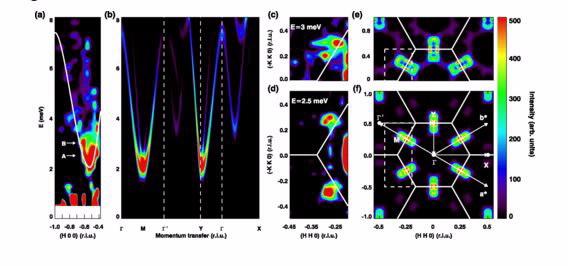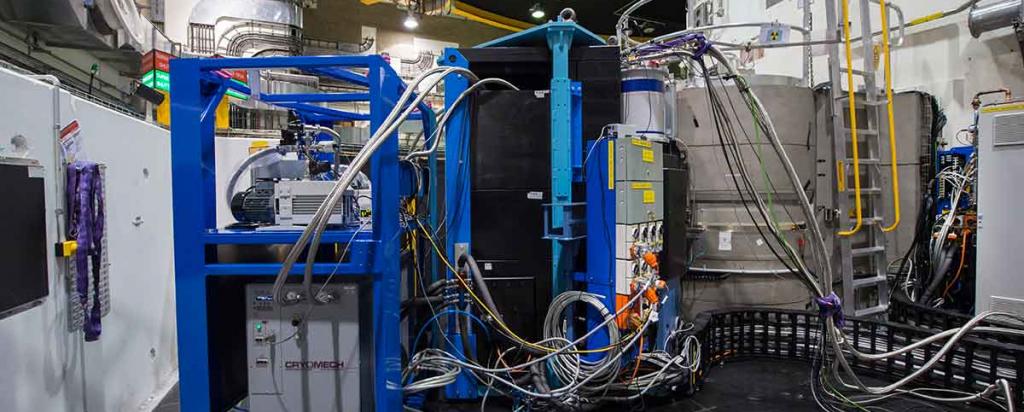

Published on the 26th July 2017 by ANSTO Staff
Inelastic neutron scattering (INS) has provided experimental evidence that the two dimensional material, alpha ruthenium trichloride, α-RuCl3 is astrong candidate for a quantum spin liquid (QSL) that fits the Kitaev theoretical model.
A large international collaboration led by researchers from Nanjing University, Peking University, Munich Technical University and ANSTO used the Taipan triple axis spectrometer at ANSTO and PUMA the triple axis spectrometer at FRM-II in Munich to determine low energy spin wave excitations associated with the exotic magnetic state in α– RuCl3.

Magnetic dispersion as captured by inelastic neutron scattering and calculations.
The research was published in Physical Review Letters earlier this year.
The compound, a layered honeycomb lattice in which the ruthenium and chlorine ions form edge sharing octahedra, had been previously proposed as a possible candidate material with a quantum spin liquid phase.
This two-dimensional material is similar to graphene sheets in its structure.
The magnetic ions in geometrically frustrated materials such as α-RuCl3 exhibit strong coupling between electron spin and orbital angular momentum.
In α-RuCl3 the strong ferromagnetic and antiferromagnetic interactions are competing with geometric frustration—the shape the magnetic ions form on the 2D triangular lattice.
The INS spectra of high quality single crystals of α– RuCl3 were well modelled by a series of magnetic interactions that were clearly dominated by the anisotropic Kitaev ferromagnetic interaction and an off-diagonal isotropic antiferromagnetic interaction.
These exchange interactions were critical to fit the data which left an almost negligible isotropic Heisenberg exchange coupling in α-RuCl3.
Quantum spin liquid
When you cool down a conventional magnet, the magnetic spins will eventually freeze into an ordered state, where each of the spins align with each other.
A QSL exists as a solid crystal but has a magnetic state that is described as liquid, and unlike the other types of magnetism, it undergoes frequent fluctuation of the magnetic orientations of its individual particles. The spins continue to move dynamically from one orientation to another.
There is no static order to the magnetic orientations but there is a strong interaction between the spins of the electrons. They do not lock in place as a result of quantum effects even at temperatures approaching zero Kelvin.
The spins simultaneously point in many different directions in a state of superimposition. Widely separated spins are, however, highly entangled collectively.
A Kitaev quantum spin liquid
One of the main theoretical descriptions for a quantum spin liquid was a model developed by Alexi Kitaev.
He proposed a model in which magnetic interaction of the effective spin is intrinsically anisotropic (directionally constrained) and geometrically frustrated due to the spatially anisotropic nature of the d orbitals and the spin orbit coupling.
It could occur when a strong crystal field split the 4d/5d orbitals into degenerate states. Subsequent spin orbit coupling of 4d/5d electrons would lift the degeneracy and produce a Mott insulating state with an effective spin configuration of ½.
Using inelastic neutron scattering to detect magnetic interaction
Because neutrons are microscopic magnets that carry no charge, they can be used to directly interact with and excite other magnetic particles in the system without compromising the integrity of the material’s atomic structure.
Neutrons can activate the ground state to an excited state by a spin flip process providing a way to measure the magnetic spectrum of excitations.
Inelastic neutron scattering at ANSTO’s centre for Neutron Scattering was undertaken by TAIPAN instrument scientists Dr Guochu Deng and Dr Sergey Danilkin.
In α-RuCl3 zigzag magnetic layers are only weakly bonded with the van der Wals force along the c axis, resulting in the quasi two dimensional nature of the magnetic interaction.
Spin dynamics were investigated within the a-b plane using inelastic neutron scattering to determine the magnetic interactions within this plane.
The data revealed clear dispersive modes across the zigzag magnetic layers, indicating strong magnetic interactions between magnetic ions within this plane. The observed spin gap was a strong indication of the anisotropy within the system.
The Heisenberg isotropic exchange, J, in which there is no preferred direction to magnetic spins, in the material is so small it is effectively cancelled out by the anisotropic magnetic interactions.
The measurements involved co- aligning 50 crystals of α-RuCl3 to have enough mass to observe such weak scattering. The INS data was produced on these single crystals as they provide more spatial information than a powder sample.
The researchers led by Jinsheng Wen of Nanking University also used X-ray spectroscopy, X-ray diffraction, and theoretical calculations to support their findings that α-RuCl3 is most likely a Kitaev quantum spin liquid.